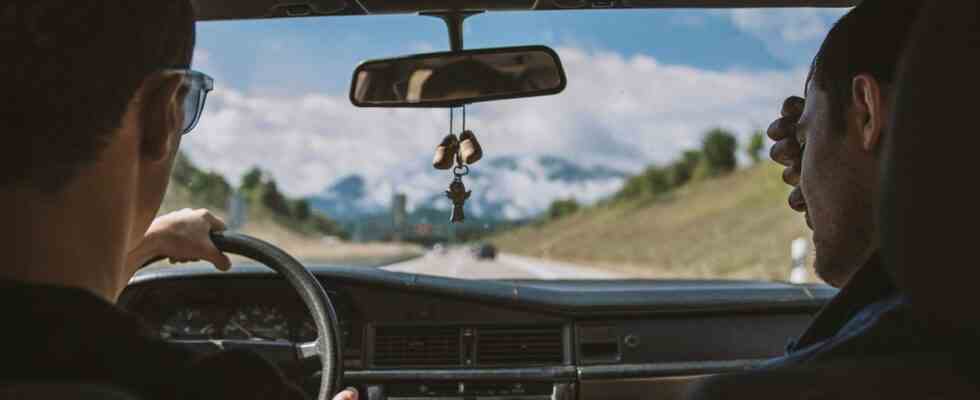Inflation, purchasing power crisis, global warming and now fuel shortages throughout the country… There are plenty of reasons to pay attention to your fuel consumption. And for many French people far from the big cities, car journeys are almost “compulsory”, whether to go to work, bring the children to school or do the shopping. So when you can’t ride less, it’s about trying to ride better. To find out how, 20 minutes tested an eco-driving course.
Appointment is therefore made in Torcy (Seine-et-Marne) with Laurent Capillon, CEO of New Route, specialist in eco-driving training. His mission ? We learn in one hour watch in hand to drive while burning as little fuel as possible. Not won when we know our southern origin and the reproaches of our relatives on our jerky and worrying steering wheel. However, Laurent, all in good nature and in easy familiarity, seems confident. In us and in himself: “In 80% of cases, the same big mistakes come back. »
Release clutch and brake
So off we go for sixty minutes on the most beautiful departmental roads in Ile-de-France and their 50 shades of pine alleys. Usually, the session breaks down as follows: a few minutes of theory, a first drive without indication. Then a point with things to improve, and a second much more efficient steering wheel. “We take the opportunity to travel from the employee’s home to work, and in their own vehicle, in order to facilitate the implementation of eco-responsible actions as much as possible,” Laurent tells us. New Routewhich officiates in IDF and PACA, takes care of companies that call on it to teach their employees, generally in a company car or with petrol included in the cost, to be economical.
But enough of contextualization, place on the road, direction Marne-la-Vallée. After 15 minutes at the wheel, while checking that Laurent’s gaze is not too judgmental, he stops us to take stock. Bingo, we tick almost all the wrong boxes. First complaint, the great classic of the foot constantly on the clutch: “Even when you think you are not pressing, you stay on it a little and causes friction with the engine”. Result, a clutch pedal that will give up the ghost sooner, and more fuel consumed.
To anticipate
Second point where we are kindly tapped on the knuckles: our lack of anticipation. Basically, we don’t look far enough and we improvise last-second braking or acceleration, not the most eco-friendly. “As soon as you have spotted a red light, a roundabout or a Stop sign, you can just let go of the accelerator pedal without pressing the brake”, advises Laurent. The small scientific name of the thing – the cut of injection – makes it possible to brake naturally while consuming zero drop of gasoline, a notable benefit. The Grail being to manage to take roundabouts without having pressed the brake once.
A need for anticipation which is accompanied by a precise instruction: stop sticking to the ass of the car in front. “If you follow it too closely, you suffer its braking and its changes of rhythm”, which quickly forces you to press the brake, a hated gesture in eco-driving. It is therefore necessary to learn to look loiiiiiiiin in front, to quickly identify future braking. A technique which, according to Laurent, makes driving more active and concentrated, and therefore less boring: “Our customers say that they are more relaxed at the wheel and more attentive”.
A car always on the move
And precisely, after having crossed these famous roundabouts, Stop signs and traffic lights, we are given a last technique, a little more counter-intuitive: reaccelerate frankly instead of doing our famous technique of acceleration very gently. “What we want is a car that’s been launched,” insists Laurent. For that, we will not hesitate to quickly change gears: the 2 must come almost automatically, and the 3, 4 and even 5 do not have to be asked. Instead of looking at our kilometers per hour, it is the engine revolutions that interest us: from 2,000 on a diesel and 2,500 on a gasoline, we change gears without being asked.
Come on, it’s time to go back to see if we’ve improved. Look straight ahead, foot out of the clutch and ride as smoothly as possible. This time, Laurent takes us back in case of not very eco-friendly driving, allowing us to improve. Another visit to the roads of Ile-de-France before parking and having the dreaded toll.
Rapid progress
And we’re doing pretty well. During our first pass, we were on an average of 47 km/h while consuming 8.8 liters per 100 kilometers. The second, we went to 50 km/h, with a consumption of 6.6 liters per 100. Yes, we even drove faster: “Except for long journeys on expressways or motorways, we not recommend slower driving, which is frustrating on a daily basis and is not necessarily very profitable. The idea, once again, is not to drive less, or slower, but to drive better”.
Two or three last tips by the way – check the tire pressure well and do not overload the car, any extra weight will consume more fuel -, a last promise to drive cleaner, and here we are, in barely an hour, to never approach roundabouts the same way again.

